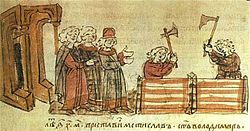Mstislav I of Kiev
This article needs additional citations for verification. (June 2016) |
Mstislav I of Kiev | |
|---|---|
 Grand Prince Mstislav I Vladimirovich built the Pirogoshcha Church of the Mother of God in Kiev | |
| Born | 1 June 1076 Turov |
| Died | 14 April 1132 (aged 55) Kiev |
| Noble family | Rurik |
| Spouse(s) | Christina Ingesdotter of Sweden Liubava Dmitrievna Zavidich |
| Father | Vladimir II Monomakh |
| Mother | Gytha of Wessex |
Mstislav I Vladimirovich the Great (Russian: Мстислав Владимирович Великий, Template:Lang-ua, Belarusian: Мсціслаў Уладзіміравіч Вялікі) (June 1, 1076, Turov – April 14, 1132, Kiev) was the Grand Prince of Kiev (1125–1132), the eldest son of Vladimir II Monomakh by Gytha of Wessex.[1] He figures prominently in the Norse Sagas under the name Harald, taken to allude to his grandfather, Harold II of England. Mstislav's Christian name was Theodore.
Biography
As his father's future successor, Mstislav reigned in Novgorod the Great from 1088–93 and (after a brief stint at Rostov) from 1095–1117. Thereafter he was Monomakh's co-ruler in Belgorod Kievsky, and inherited the Kievan throne after his death. He built numerous churches in Novgorod, of which St. Nicholas Cathedral (1113)[2] and the cathedral of St Anthony Cloister (1117) survive to the present day. Later, he would also erect important churches in Kiev, notably his family sepulchre at Berestovo and the church of Our Lady at Podil.

Mstislav's life was spent in constant warfare with Cumans (1093, 1107, 1111, 1129), Estonians (1111, 1113, 1116, 1130), Lithuanians (1131), and the princedom of Polotsk (1127, 1129). In 1096, he defeated his uncle Oleg of Chernigov on the Koloksha River, thereby laying foundation for the centuries of enmity between his and Oleg's descendants. Mstislav was the last ruler of united Rus, and upon his death, as the chronicler put it, "the land of Rus was torn apart".
In 1095, Mstislav wed Princess Christina Ingesdotter of Sweden, daughter of King Inge I of Sweden.[3] They had many children:
- Ingeborg of Kiev, married Canute Lavard of Jutland, and was mother to Valdemar I of Denmark
- Malmfred, married (1) Sigurd I of Norway; (2) Eric II of Denmark
- Eupraxia, married Alexius Comnenus, son of John II Comnenus
- Vsevolod of Novgorod and Pskov
- Maria, married Vsevolod II of Kiev
- Iziaslav II of Kiev
- Rostislav of Kiev
- Sviatopolk of Pskov
- Rogneda, married Yaroslav of Volinya
- Xenia, married Briachislav of Izyaslawl
Christine died on January 18, 1122; later that year Mstislav married again, to Ljubava Saviditsch, the daughter of Dmitry Saviditsch, a nobleman of Novgorod. Their children were:
- Vladimir III Mstislavich (1132–1171)
- Euphrosyne of Kiev, (c. 1130 – c. 1193) married King Géza II of Hungary in 1146.
Through Euphrosyne, Mstislav is an ancestor of both Philippa of Hainault and King Edward III of England, hence of all subsequent English and British monarchs. Through his mother Gytha, he is part of a link between Harold II of England and the modern line of English kings founded by William the Conqueror, who deposed him.
Ancestry
| Family of Mstislav I of Kiev | |||||||||||||||||||||||||||||||||||||||||||||||||||||||||||||||||||||||||||||||||||||||||||||||||||||||||||||||||||||||||||||||||||||||||||||||||||||||||||||||||||||||||||||||||||||||||||||||||||||||||||||||||||||||||||||||||||||||||||||||||||||||||||||||||||||||||||||||||||||||||||||||||||||||||||||||||||||||||||||||||||||||||||||||||||||||||||||||||||||||||||||||||||||||||||||||||||||||||||||||||||||||||||||||||||||||||||||||||||||||||||||||||||||||||||||||||||||||||||||||||||||||||||||||||||||||||||||||||||||||||||||||||||||||||||||
|---|---|---|---|---|---|---|---|---|---|---|---|---|---|---|---|---|---|---|---|---|---|---|---|---|---|---|---|---|---|---|---|---|---|---|---|---|---|---|---|---|---|---|---|---|---|---|---|---|---|---|---|---|---|---|---|---|---|---|---|---|---|---|---|---|---|---|---|---|---|---|---|---|---|---|---|---|---|---|---|---|---|---|---|---|---|---|---|---|---|---|---|---|---|---|---|---|---|---|---|---|---|---|---|---|---|---|---|---|---|---|---|---|---|---|---|---|---|---|---|---|---|---|---|---|---|---|---|---|---|---|---|---|---|---|---|---|---|---|---|---|---|---|---|---|---|---|---|---|---|---|---|---|---|---|---|---|---|---|---|---|---|---|---|---|---|---|---|---|---|---|---|---|---|---|---|---|---|---|---|---|---|---|---|---|---|---|---|---|---|---|---|---|---|---|---|---|---|---|---|---|---|---|---|---|---|---|---|---|---|---|---|---|---|---|---|---|---|---|---|---|---|---|---|---|---|---|---|---|---|---|---|---|---|---|---|---|---|---|---|---|---|---|---|---|---|---|---|---|---|---|---|---|---|---|---|---|---|---|---|---|---|---|---|---|---|---|---|---|---|---|---|---|---|---|---|---|---|---|---|---|---|---|---|---|---|---|---|---|---|---|---|---|---|---|---|---|---|---|---|---|---|---|---|---|---|---|---|---|---|---|---|---|---|---|---|---|---|---|---|---|---|---|---|---|---|---|---|---|---|---|---|---|---|---|---|---|---|---|---|---|---|---|---|---|---|---|---|---|---|---|---|---|---|---|---|---|---|---|---|---|---|---|---|---|---|---|---|---|---|---|---|---|---|---|---|---|---|---|---|---|---|---|---|---|---|---|---|---|---|---|---|---|---|---|---|---|---|---|---|---|---|---|---|---|---|---|---|---|---|---|---|---|---|---|---|---|---|---|---|---|---|---|---|---|---|---|---|---|---|---|---|---|---|---|---|---|---|---|---|---|---|---|---|---|---|---|---|---|---|---|---|---|---|---|---|---|---|---|---|---|---|---|---|---|---|---|---|---|---|---|---|---|---|---|---|---|---|---|---|---|---|---|---|---|---|---|---|---|---|---|---|---|---|---|---|---|---|---|---|---|---|---|---|---|---|---|---|---|---|---|---|---|---|---|---|---|---|---|---|---|---|---|---|---|---|---|---|---|---|---|---|---|---|---|---|---|---|---|---|---|---|
| |||||||||||||||||||||||||||||||||||||||||||||||||||||||||||||||||||||||||||||||||||||||||||||||||||||||||||||||||||||||||||||||||||||||||||||||||||||||||||||||||||||||||||||||||||||||||||||||||||||||||||||||||||||||||||||||||||||||||||||||||||||||||||||||||||||||||||||||||||||||||||||||||||||||||||||||||||||||||||||||||||||||||||||||||||||||||||||||||||||||||||||||||||||||||||||||||||||||||||||||||||||||||||||||||||||||||||||||||||||||||||||||||||||||||||||||||||||||||||||||||||||||||||||||||||||||||||||||||||||||||||||||||||||||||||||
See also
References
- ^ Philip Line, Kingship and State Formation in Sweden 1130-1290, (Brill, 2007), 597.
- ^ George Heard Hamilton, The Art and Architecture of Russia, (Yale University Press, 1983), 43.
- ^ The Kiev State and Its Relations with Western Europe, F. Dvornik, Transactions of the Royal Historical Society, Vol. 29 (1947), 41.
